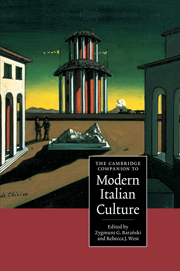Book contents
- Frontmatter
- Introducing modern Italian culture
- 1 The notion of Italy
- 2 Social and political cultures in Italy from 1860 to the present day
- 3 Questions of language
- 4 Intellectuals, culture and power in modern Italy
- 5 Catholicism
- 6 Socialism, Communism and other ‘isms’
- 7 Other voices: contesting the status quo
- 8 Narratives of self and society
- 9 Searching for new languages: modern Italian poetry
- 10 Drama: realism, identity and reality on stage
- 11 Italian cinema
- 12 Art in modern Italy: from the Macchiaioli to the Transavanguardia
- 13 A modern identity for a new nation: design in Italy since 1860
- 14 Fashion: narration and nation
- 15 The media
- 16 Since Verdi: Italian serious music 1860-1995
- 17 Folk music and popular song from the nineteenth century to the 1990s
- 18 Epilogue: Italian culture or multiculture in the new millennium?
- Index
- Series List
16 - Since Verdi: Italian serious music 1860-1995
Published online by Cambridge University Press: 28 May 2006
- Frontmatter
- Introducing modern Italian culture
- 1 The notion of Italy
- 2 Social and political cultures in Italy from 1860 to the present day
- 3 Questions of language
- 4 Intellectuals, culture and power in modern Italy
- 5 Catholicism
- 6 Socialism, Communism and other ‘isms’
- 7 Other voices: contesting the status quo
- 8 Narratives of self and society
- 9 Searching for new languages: modern Italian poetry
- 10 Drama: realism, identity and reality on stage
- 11 Italian cinema
- 12 Art in modern Italy: from the Macchiaioli to the Transavanguardia
- 13 A modern identity for a new nation: design in Italy since 1860
- 14 Fashion: narration and nation
- 15 The media
- 16 Since Verdi: Italian serious music 1860-1995
- 17 Folk music and popular song from the nineteenth century to the 1990s
- 18 Epilogue: Italian culture or multiculture in the new millennium?
- Index
- Series List
Summary
1860–1900
In the years immediately following the unification of Italy, serious musical activity throughout the peninsula was still overwhelmingly dominated by opera, as it had been during the Risorgimento period. In all the major cities, and many smaller ones too, the operatic public was large and various, and was still at least as interested in new operas as in established 'classics'. At this time, one senior living Italian opera composer towered above all others, dwarfing them so drastically that most of them are nowadays hardly remembered even in their own country: Giuseppe Verdi (1813-1901) is now regarded everywhere as the only really lastingly important Italian composer who was active across the third quarter of the nineteenth century, and indeed as one of the greatest opera composers who ever lived. Although Verdi became markedly less prolific in his later years, many (perhaps most) of his finest works date from after 1860, and Aida (1871), Otello (1887) and Falstaff (1893) have long been rated among the highest achievements of Italian genius in any field. However, by the time the two last-mentioned operas were written, the semi-retired Verdi had come to occupy a less unquestionably central place in Italian musical life, and new creative developments were emerging which in various ways showed signs of transforming the character of the new music being written at the time.
- Type
- Chapter
- Information
- The Cambridge Companion to Modern Italian Culture , pp. 311 - 324Publisher: Cambridge University PressPrint publication year: 2001
- 1
- Cited by

